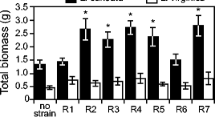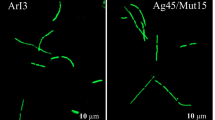Abstract
The effect of soil pH on the competitive abilities of two rhizobial strains was investigated in two sterile systems. The two strains come from wild plants of the endemic shrubby legumes Cytisus multiflorus (cmu) and Cytisus balansae (cba). Strains were used to infect seedlings of C. multiflorus, C. balansae, and Ornithopus compressus, grown in soil and hydroponics with acidic and neutral pH. All seedlings were inoculated with a single-strain inoculum containing 106 total cells of one of the two test strains or with a mixed inoculum (1:1 cmu:cba). Controls consisted of non-inoculated seedlings. At harvest, nodule occupants were determined by PCR. The majority of nodules (>95 %) formed on plants grown in acidic soil were occupied by cmu strain. This pattern of nodule occupancy changed in neutral pH both in soil and in hydroponics. When cmu was paired with cba, the former formed 78 % of the nodules in the acidic media and the number of nodules formed by cba was higher in neutral media (8 %). When nodule occupancy was dominated by cmu, the total nitrogen and biologically fixed nitrogen were higher in C. multiflorus and O. compressus. The different nodule occupancy percentages indicate a correlation between the preferred growing conditions of both host plants and Bradyrhizobia strains. Results indicate that soil pH can influence which symbiotype will competitively nodulate C. multiflorus and C. balansae in the field which accounts for the current distribution of these two plants.



Similar content being viewed by others
References
Ahnia H, Boulila F, Boulila A, Boucheffa K, Durán D, Bourebaba Y, Salmi A, Imperial J, Ruiz-Argüeso T, Rey L (2014) Cytisus villosus from Northeastern Algeria is nodulated by genetically diverse Bradyrhizobium strains. Antonie Van Leeuwenhoek 105(6):1121–1129
Amarger N, Sommer G, Giraud JJ, Lagacherie B (1984) Rhizobium lupini: Presence et survie dans les sols, selection des souches et inoculation des semences de lupin. In Proceedings of the 3rd international lupin conference, La Rochelle, pp 599–600
Appunu C, Dhar B (2006) Symbiotic effectiveness of acid-tolerant Bradyrhizobium strains with soybean in low pH soil. Afr J Biotechnol 5(10):842–845
Avelar-Ferreira PA, Bomfeti CA, Lima-Soares B, de Souza Moreira FM (2012) Efficient nitrogen-fixing Rhizobium strains isolated from Amazonian soils are highly tolerant to acidity and aluminium. World J Microbiol Biotech 28:1947–1959
Bertil P, Goran B, Francois T, Mathias U, Karlerik J (1998) Molecular evolution of Mycoplasma capricolum subsp. capripneu moniae strains based on polymorphisms in the 16S rRNA genes. J Bacteriol 180:2350–2358
Blagodatskaya EV, Anderson TH (2009) Interactive effects of pH and substrate quality on the fungal-to-bacterial ratio and qCO2 of microbial communities in forest soils. Soil Biol Bioch 30:1269–1274
Brockwell J, Searle SD, Jeavons AC, Waayers M (2005) Nitrogen fixation in acacias: an untapped resource for sustainable plantations, farm forestry and land reclamation. Austr Cent Int Agric Res Monogr 155:1–132
Burbank L, Mohammadi M, Roper C (2015) Siderophore mediated iron acquisition influences motility and is required for full virulence of the xylem-dwelling bacterial phytopathogen Pantoea stewartii subsp. Stewartii. Appl Environ Microbiol 81:139–148. doi:10.1128/AEM.02503-14
Cardinale M, Lanza A, Bonnì M, Marsala S, Puglia A, Quatrini P (2008) Diversity of rhizobia nodulating wild shrubs of Sicily and some neighbouring islands. Arch Microbiol 190(4):461–470
Chahboune R, Carro L, Peix A, Barrijal S, Velázquez E, Bedmar J (2011) Bradyrhizobium cytisi sp. nov., isolated from effective nodules of Cytisus villosus. Int J Syst Evol Microbiol 61(12):2922–2927
Chooi-Hua G, Veliz Vallejos DF, Nicotra AB, Mathesius U (2013) The impact of beneficial plant-associated microbes on plant phenotypic plasticity. J Chem Ecol 39:826–839
Cooper JE, Wood M, Holding AJ (1983) The influence of soil acidity factors on rhizobia. In: Jones DG, Davies DR (eds) Temperate legumes. Pitman, London, pp 319–335
Dilworth MJ, Howieson JG, Reeve WG, Tiwari RP, Glenn AR (2001) Acid tolerance in legume root nodule bacteria and selecting for it. Aust J Exp Agric 41:435–446
Dilworth MJ, James EK, Sprent JI, Newton WE (2008) Nitrogen-fixing leguminous symbiosis, vol 7., Nitrogen fixation: origins, applications, and research progressSpringer, The Netherlands
Dowling DN, Broughton WJ (1986) Competition for nodulation of legumes. Annu Rev Microbiol 40:131–157. doi:10.1146/annurev.mi.40.100186.001023
Dughri MH, Bottomley PJ (1984) Soil acidity and the composition of an indigenous population of Rhizobium trifolii in nodules of different cultivars of Trifolium subterraneum L. Soil Biol Biochem 16:405–411
Gerding M, Howieson JG, O’Hara GW, Real D, Bräu L (2013) Establishment and survival of the South African legume Lessertia spp. and rhizobia in Western Australian agricultural systems. Plant Soil 370:235–249. doi:10.1007/s11104-013-1632-1
Graham PH (1992) Stress tolerance in Rhizobium and Bradyrhizobium, and nodulation under adverse soil conditions. Can J Microb 38:475–484
Grönemeyer JL, Kulkarni A, Berkelmann D, Hurek T, Reinhold-Hurek B (2014) Rhizobia Indigenous to the Okavango Region in Sub-Saharan Africa: diversity, adaptations, and host specificity. Appl Environ Microbiol 80:7244–7257
Gualtieri G, Bisseling T (2000) The evolution of nodulation. Plant Mol Biol 42:181–194
Gubry-Rangin C, Garcia M, Béna G (2010) Partner choice in Medicago truncatula-Sinorhizobium symbiosis. Proc Royal Soc 277:1947–1951
Haag AF, Arnold MFF, Myka KK, Kerscher B, Dall’Angelo S, Zanda M, Mergaert P, Ferguson GP (2013) Molecular insights into bacteroid development during Rhizobium–legume symbiosis. FEMS Microbiol Rev 37:364–383
Hoagland DR, Arnon DI (1950) The water-culture method of growing plants without soil. California Agricultural Experiemtn Station, Berkeley, p 347
Hodge A, Stewart J, Robinson D, Griffiths BS, Fitter AH (2000) Competition between roots and soil-microorganisms for nutrients from nitrogen-rich patches of varying complexity. J Ecol 88:150–164
Howieson J, Ballard R (2004) Optimising the legume symbiosis in stressful and competitive environments within southern Australia–some contemporary thoughts. Soil Biol Biochem 36:1261–1273
Janczarek M, Rachwal K, Ciesla J, Ginalska G, Bieganowski A (2015) Production of exopolysaccharide by Rhizobium leguminosarum bv. Trifolii and its role in bacterial attachment and surface properties. Plant Soil 388:211–227
Kanu SA, Dakora F (2012) Effect of N and P nutrition on extracellular secretion of lumichrome, riboflavin and indole acetic acid by N2-fixing bacteria and endophytes isolated from Psoralea nodules. Symbiosis 57:15–22
Lafay B, Burdon JJ (2006) Molecular diversity of rhizobia nodulating the invasive legume Cytisus scoparius in Australia. J Appl Microbiol 100(6):1228–1238
Laranjo M, Oliveira S (2011) Tolerance of Mesorhizobium type strains to different environmental stresses. Antonie Van Leeuw 99(3):651–662. doi:10.1007/s10482-010-9539-9
Lindstrom K, Myllyniemi H (1987) Sensitivity of red clover rhizobia to soil acidity factors in pure culture and in symbiosis. Plant Soil 98:353–362
Marco DE, Carbajal JP, Cannas S, Pérez-Arnedo R, Hidalgo-Perea A, Olivares J, Ruiz-Sain JE, Sanjuán J (2009) An experimental and modeling exploration of the host-sanction hypothesis in legume-rhizobia mutualism. J Theor Biol 259:423–433
Nandasena KG, O’Hara GW, Tiwari RP, Willems A, Howieson JG (2009) Mesorhizobium australicum sp. nov. and Mesorhizobium opportunistum sp. nov., isolated from Biserrula pelecinus L. in Australia. Int J Syst Evol Microb. 59:2140–2147
Narożnaa D, Pudełkoa K, Króliczaka J, Golińskaa B, Masayuki Sugawarab M, Mądrzaka CJ, Sadowskyb MJ (2015) Survival and competitiveness of Bradyrhizobium japonicum strains twenty years after. Appl Environ Microbiol. doi:10.1128/AEM.01399-15
Nguyen MT, Akoyoshi K, Nakatsukasa M, Saeki Y, Yokoyama K (2010) Multiple occupancy of nodules by nodulating rhizobia on field-grown soybeans with attendance of Sinorhizobium spp. Soil Sci Plant Nutr 56:382–389
Pankhurst CE (1981) Effect of plant nutrient supply on nodule effectiveness and Rhizobium strain competition for nodulation of Lotus pedunculatus. Plant Soil 60:325–339
Pérez-Fernández MA, Lamont BB (2003) Nodulation and performance of exotic and native legumes in Australian soils. Aust J Bot 51:543–553
Pérez-Fernández M, Lamont BB (2015) Competition and facilitation between Australian and Spanish legumes in seven Australian soils. Plant Species Biol (In press)
Pérez-Fernández MA, Gómez-Gutiérrez JM, Vicente-Villardón JL, Martín-Berrocoso AM (2000) Germination of nine legumes indigenous to the Iberian Peninsula in relation to soil substratum characteristics. J Medit Ecol 1:141–153
Perret X, Staehelin C, Broughton WJ (2000) Molecular basis of symbiotic promiscuity. Microb Mol Biol Rev 64:180–201
Rodríguez-Echeverría S, Pérez-Fernández MA (2005) Potential use of Iberian shrubby legumes and rhizobia inoculation in re-vegetation projects under acidic soil conditions. Appl Soil Ecol 29:203–220
Rodríguez-Echeverría S, Pérez-Fernández M, Vlaar S, Finnan T (2003) Analysis of the legume–rhizobia symbiosis in shrubs from central western Spain. J Appl Microbiol 95:1367–1374
Ruiz-Díez B, Fajardo S, Puertas-Mejía M, Felipe M, Fernández-Pascual M (2009) Stress tolerance, genetic analysis and symbiotic properties of root-nodulating bacteria isolated from Mediterranean leguminous shrubs in Central Spain. Arch Microbiol 191(1):35–46
Sarruge JR, Haag HP (1979) Análises químicas em plantas. ESALQ/USP, 27
Shiro S, Yamamoto A, Umehara Y, Hayashi M, Sigua GC (2012) Effect of Rj genotype and cultivation temperature on the community structure of soybean-nodulating bradyrhizobia. App Environ Microbiol 78:1243–1250
Simms EL, Taylor DL, Povich J, Shefferson RP, Sachs JL, Urbina M, Tausczik Y (2006) An empirical test of partner choice mechanisms in a wild legume-rhizobium interaction. Proc R Soc Lond 273:77–78
Simsek S, Ojanen-Reuhs T, Stephens SB, Reuhs BL (2007) Strain-ecotype specificity in Sinorhizobium meliloti–Medicago truncatula symbiosis is correlated to succinoglycan oligosaccharide structure. J Bacteriol 189:7733–7740. doi:10.1128/JB.00739-07
Soto MJ, Domínguez-Ferreras A, Pérez-Mendoza D, Sanjuán J, Olivares J (2009) Mutualism versus pathogenesis: the give-and-take in plant-bacteria interactions. Cell Microb 11:381–388
Sprent JI, Sutherland JM, Faria SMd (1987) Some aspects of the biology of nitrogen-fixing organisms. Philos Trans R Soc B 317:111–129
Stone CE, Cooper JE (1997) Nodulation of Trifolium repens at low pH by simple and paired strains of Rhizobium leguminosarum biovar trifolii. Arch Microbiol 168:193–198
Streit W, Botero L, Werner D, Beck D (1995) Competition for nodule occupancy on Phaseolus vulgaris by Rhizobium etli and Rhizobium tropici can be efficiently monitored in an ultisol during the early stages of growth using a constitutive GUS gene fusion. Soil Biol Biochem 27:1075–1082
Suzuky Y, Adhikari D, Itoh K, Suyama K (2014) Effects of temperature on competition and relative dominance of Bradyrhizobium japonicum and Bradyrhizobium elkanii. Plant Soil 374:915–924
Tang C, Robson A, Longnecker N, Buirchell B (1995) The growth of Lupinus species on alkaline soils. Aust J of Agric Res 46:255–268
Thrall PH, Laine A-L, Broadhurst LM, Bagnall DJ, Brockwell J (2011) Symbiotic Effectiveness of rhizobial mutualists varies in interactions with native Australian legume genera. PLoS One 6(8):e23545. doi:10.1371/journal.pone.0023545
Triplett EW, Sadowsky MJ (1992) Genetics of competition for nodulation of legumes. Annu Rev Microbiol 42:399–428. doi:10.1146/annurev.mi.46.100192.002151
Valladares F, Villar-Salvador P, Domínguez S, Fernández- Pascual S, Peñuelas JL, Pugnaire FI (2002) Enhancing the early performance of the leguminous shrub Retama sphaerocarpa (L.) Boiss.: fertilisation versus Rhizobium inoculation. Plant Soil 240:253–262
Valverde C, Ferrari A, Wall LG (2009) Effects of calcium in the nitrogen-fixing symbiosis between actinorhizal Discaria trinervis (Rhamnaceae) and Frankia. Symbiosis 49:151–155
Versalovic J, Schneider M, de Bruijn FJ, Lupski JR (1994) Genomic fingerprinting of bacteria using repetitive sequence-based polymerase chain reaction. Methods Mol Cell Biol 5:25–40
Vincent JM (1970) A manual for the practical study of root-nodule bacteria. Blackwell Scientific Publications Ltd, Oxford
Walsh KB (1995) Physiology of the legume nodule and its response to stress. Soil Biol Biochem 27:637–655
Wielbo J, Kuske J, Marek-Kozaczuk M, Skorupska A (2010) The competition between Rhizobium leguminosarum bv. viciae strains progresses until late stages of symbiosis. Plant Soil 337:125–135
Yates RJ, Howieson JG, Reeve WG, O’Hara GW (2011) A reappraisal of the biology and terminology describing rhizobial strain success in nodule occupancy of legumes in agriculture. Plant Soil 348:255–267
Acknowledgments
The authors wish to thank Keely Graskamp and Lucas MacKenzie for their excellent technical assistance in the setting up of the hydroponic experiment and Jesús Rodríguez del Gran Poder, for constant support in preparing fresh Hoagland’s nutritive solution and contributing with inspiring biological ideas.
Author information
Authors and Affiliations
Corresponding author
Additional information
Communicated by Sarah M Emery, Ph.D.
Electronic supplementary material
Below is the link to the electronic supplementary material.
Rights and permissions
About this article
Cite this article
Pérez-Fernández, M.A., Hill, Y.J., Calvo-Magro, E. et al. Competing Bradyrhizobia strains determine niche occupancy by two native legumes in the Iberian Peninsula. Plant Ecol 216, 1537–1549 (2015). https://doi.org/10.1007/s11258-015-0536-y
Received:
Accepted:
Published:
Issue Date:
DOI: https://doi.org/10.1007/s11258-015-0536-y




